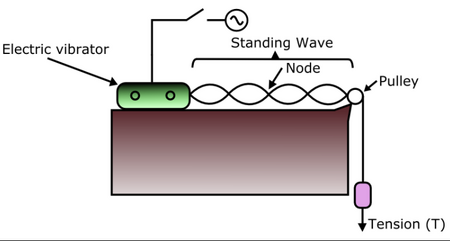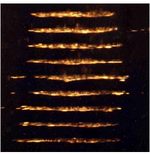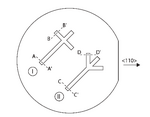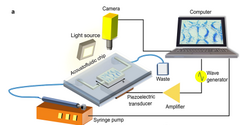Standing Waves - Tyler Kimball & Sean Corriveau
Background

Standing waves were first noticed by Michael Faraday in 1831 through the observance of water in a container.[1] Faraday noticed the vibrations on the surface of the liquid, but it would not be until the 1860s that this phenomena would be characterized thoroughly by Melde Franz. Melde Franz would be the one to characterize the vibrations as standing waves with the use of strings tied to a tuning fork.[2] "Melde's Experiment" attempted to demonstrate that mechanical waves undergo interface phenomena, and that these waves traveled in opposite directions to form immobile points known as nodes. The name 'standing wave' was dubbed due to the ends attached to the forks (nodes) are fixed which transfer energy toward the string creating areas of high and low pressure points where the desired particles can be directed towards. These pressure changes are caused by the magnitude of the amplitude and the certain number of periods that one can fit in the nodes. Through the introduction of these forces scientists make it possible to achieve particle separation.

Standing Wave Separation
Standing waves are typically used for the separation of suspended particles in a liquid acoustic field. The interaction of standing ultrasonic waves with particles dispersed in a fluid produces forces on the particles, which can be utilized for the separation of the dispersed particles from the fluid.[3] The pressure differences created from the combination of amplitudes correlate to the number of periods in a wave. There are four wave principles that are used for separation: bands effect, acoustophoretic coefficient, particle density, and sweep frequency.[4] The larger the particle the easier the it is to force the particle to the desired location and once the particle has reached the location the rest of the particles of similar size will band together which is known as the band effect.[5] Particles of similar size will always line up together and congregate following one after the other making the standing wave separation very useful especially if you have particles of different sizes. The acoustophoretic coefficient is used to create the force necessary for the desired particle to separate and maintain suspension in the liquid.[6] This coefficient is dependent on characteristics of size, density, and trajectory of a particle. These properties thus allow for calculations of compressibility to be performed and correlate to the standing motion of a wave.[7] The sweep frequency is the frequency necessary to maintain a standing wave at the initial time a moving wave is produced. A continuous frequency is necessary to maintain the wave for separation, that is, when driving frequency being applied to a system is equal to its natural frequency. Producing standing waves is relatively effortless compared to traveling waves of the same amplitude, as traveling waves would require a more complex frequency.[8]

Applications
Standing waves can be applied to several different areas of microfluidics, with one of the main uses being for separation of particles. Laurel et al. used standing waves in their elastomer microfluidic device to separate particles of different sizes into bands that can be tracked. They would later use the particles for desired experiments.[5] Other areas where standing waves can be used are petroleum separation when dealing with the un-refined oil that is mixed with various compounds until separation. In offshore extraction of crude oil, water is produced in oil emulsion and requires significant chemical demulsifiers to destroy the oil/water film. Standing waves have been found to be useful in reducing the dosage of these chemicals, as chambers using acoustic radiation can induce the joining of stable water droplets at pressures within the standing wave field.[9]

The use of algorithms to manipulate acoustic waves and microparticle environments has also recently been researched with the goal of working towards manipulation of microparticles inside unstructured environments. Yiannacou and Sariola propose a closed-loop two-dimensional algorithm model for particle manipulation that controls the frequency of a single transducer and adapts to chip and particle property changes. In terms of cell and particle sorting, this method is revolutionary as a form of contactless manipulation, and paves way for new discoveries in microchip fabrication properties.[10]
References
[1] Scott, A. (2005). Encyclopedia of Nonlinear Science (1st ed.). Routledge. p. 683.
[2] Melde, F. (1884). Akustische Experimentaluntersuchungen. Annalen der Physik, 257(3), 452–470.
[3] Benes, E., et al. (2001). Ultrasonic separation of suspended particles. 2001 IEEE Ultrasonics Symposium Proceedings, 1, 649-659.
[4] Spengler, J. F., Jekel, M., Christensen, K. T., Adrian, R. J., Hawkes, J. J., Coakley, W. T. (2000). Observation of yeast cell movement and aggregation in a small-scale MHz-ultrasonic standing wave field. Bioseparation, 9, 329-341.
[5] Laurell, T., Petersson, F., Nilsson, A. (2007). Chip integrated strategies for acoustic separation and manipulation of cells and particles. Chemical Society Reviews, 36, 492–506.
[6] Hawkes, J. J., Coakley, W. T., Gröschl, M., Benes, E., Armstrong, S., Tasker, P. J., Nowotny, H. (2002). Single half-wavelength ultrasonic particle filter: Predictions of the transfer matrix multilayer resonator model and experimental filtration results. The Journal of the Acoustical Society of America, 111(3), 1259-1266.
[7] Wang, H., Zhongzheng, L., Shin, D. M. (2013). Acoustophoretic force-based compressibility measurement of cancer cells having different metastatic potential. Proceedings of Meetings on Acoustics, 9(1), 19-45.
[8] Elert, G. (2008). Standing Waves. The Physics Hypertextbook, 5, 115-130.
[9] Atehortúa, C. M. G., Pérez, N., Andrade, M. A. B., Pereira, L. O. V., Adamowski, J. C. (2019). Water-in-oil emulsions separation using an ultrasonic standing wave coalescence chamber. Ultrason Sonochem, 5(7), 48-61.
[10] Yiannacou, K., Sariola, V. (2021). Controlled Manipulation and Active Sorting of Particles Inside Microfluidic Chips Using Bulk Acoustic Waves and Machine Learning. Langmuir, 37, 4192-4199.
